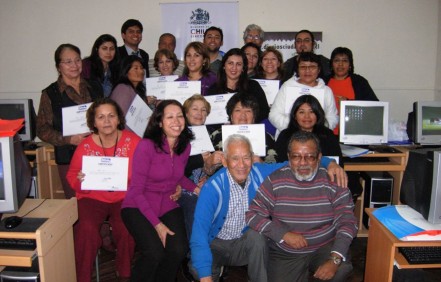
Photo: Courtesy of Mi Voz
A Chilean community news network is succeeding on two fronts where countless online media projects fail: mobilizing ?citizen journalists? and actually making the venture profitable.
Mi Voz is a network of 20 media outlets that boasts a combined force of 30,000 ?citizen correspondents? from the Peruvian border in the north to Patagonia in the south. The volunteer contributors submit original stories, which are then vetted by professional editors. Of the 20 outlets, 16 are local dailies and four are topical magazines.? Together they bring in a combined traffic of 2.5 million unique visitors per month. Not bad in a nation of 17 million.
?We wanted to create a space where we could create something different ? a community public forum that could last over the long term,? said Paula Rojo, one of the project?s founders.
Eight years since launching, Mi Voz is bringing in $2 million yearly and does not rely upon foundation or government support. Its diverse business model came together four years after launching and combines traditional advertising with community outreach and research studies. The company employs both regional and national advertising ? including government agencies and local businesses. ?Sales have increased yearly, along with traffic.
Rojo, a designer by profession, said the initial goal was not to create a business, but to tell the stories from regions outside of Santiago which are rarely heard in Chile. The news coverage that did exist was generally about scandals or crime. In response, the network launched in 2005, after the co-founder Jorge Dom?nguez observed how Korea?s Oh My News?was activating residents to tell their own stories.
When Rojo and Dominguez shared their plan for a citizen news outlet with national networks, the response was that there was no way it could succeed without crime, sex, and scandal. But Mi Voz persevered, proving that people were interested in other types of stories and that such an enterprise could be lucrative.
?We want to create a space where citizens, leaders, and officials can converse and discuss the collective future of the city,? Rojo said.
The staff has grown to more than 50 people, about eight of whom work exclusively on the business side. A local editor is based in each city. In addition to vetting stories and working on copy, editors are also responsible for mobilizing and training residents and sometimes help by providing reporters a workspace with Internet capability.
Rojo said they have never received a complaint about the lack of pay from their contributors: ?They feel owners of the media,? she said. ?They can have influence.?

Participants of a Mi Voz training. | Photo: Courtesy of Mi Voz
Part of Mi Voz?s philosophy is to not limit who is involved. They include submissions from public officials, representatives of community organizations, and even businesses right alongside reports from more objective ?citizen correspondents.? In an area where mining is controversial, for example, both the mining companies and residents opposed to the mining can post. The editor tries to facilitate discussion, however, and make sure that one voice does not dominate. ?We are interested in the conversation, the discussion,? Rojo said.
In the future, Rojo said, that online public forum may expand. She would not reveal where, but she said Mi Voz is now exploring ways to expand its forum for community correspondents and profitable business to other nations in Latin America.
Mi Voz is just one of many new journalism initiatives springing up across Latin America. In April, 14 initiatives from across South America and Spain participated in the Knight Center for Journalism in the Americas Ibero-American Colloquium on Digital Journalism.
Here are some of the other projects worth following:
Animal Politico
In three years, the Mexican online political site Animal Politico ? think part Politico, part Buzz Feed ? has grown to have the largest social media presence in Mexico, claiming more than 375,000 Twitter followers and 469,000 Facebook likes.
A P?blica?
A P?blica is a women-run investigative network based in Brazil. Similar to Center for Investigative Reporting or ProPublica, A P?blica makes an effort to partner with publications on stories to hit a larger audience. CIPER Chile ?and IDL-Reporteros?in Peru are two similar investigative networks.
Anfibia and Plaza P?blica
Some Latin American universities are supporting new sites that do insight and investigative reporting. ?Anfibia, from the National San Mart?n University in Buenos Aires, Argentina, was created in an attempt to translate academic research and language to the larger communities. Plaza P?blica, from Guatemala, is affiliated with the University Rafael Land?var in Guatemala City, which invited a ?group of journalists to create a digital media that supported the construction and defense of a solid democracy.?
charles barkley valentines valentines day George Ferris happy valentines day all star game blue ivy carter
No comments:
Post a Comment
Note: Only a member of this blog may post a comment.